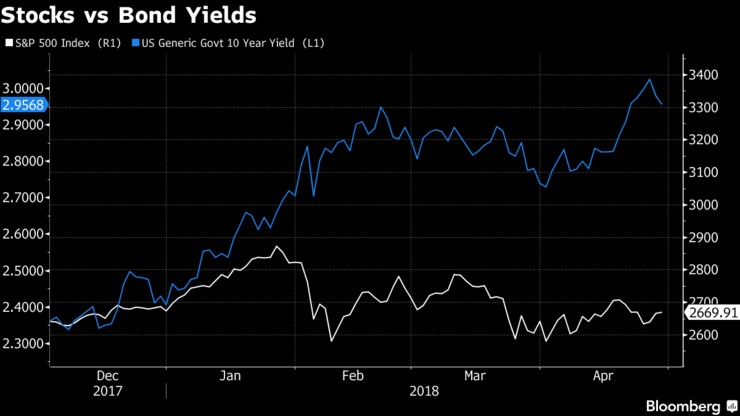Transition periods in the money markets bring with them a level of uncertainty and tend to be quite turbulent. And that aptly describes the current period when markets are beginning to react to the long-term impact of rising U.S. interest rates.
One dead giveaway is the tepid nature of the equities markets and the indifference they have been showing even in the face of strong earnings after Trump's tax cuts.
It’s been a sideways shuffle all year long, so far.
Bond market bull run on last legs

(Click to enlarge)
Source: CNBC
There are rampant fears that the bond market bull run could be on its last legs because markets are about to enter a phase that was last seen 72 years ago--a rising rates cycle.
The current falling rate cycle has lasted 36 years, with rates declining from an all-time high of 15.84 percent in 1981 to lows of 1.36 percent in 2016.
Since then, the downtrend appears to have been broken, and even tested the psychologically important 3 percent a couple of days ago.
Interest rate cycles tend to be long, typically lasting 22-37 years. This implies that the new phase we have entered could last at least two decades and possibly put a snag on the equities bull market.
Rising rates tend to put a damper on stocks markets, though that is usually not a problem until they get to around 5 percent.
U.S. 10-year Treasury yields touched 3 percent about a week ago, leading to falling stock markets not only in the U.S. but across global markets as well. The good part is that with the Fed raising interest rates a measly 25 basis points, it could take a couple of years before they test the 5-percent danger zone.
Fears on rates and flattening yield curves overdone

(Click to enlarge)
Source: Bloomberg
JPMorgan though has other ideas.
The giant bank says it does not share investors' obsession with 3-percent 10-year and flattening yield curves, saying only one bond selloff over the past 15 years has been linked to stock market weakness. Related: Is The SEC Warming Up To Cryptocurrencies?
Moreover, the rate of climb is slowing down, with the current 0.8-percent clip in real terms for the 10-year about 75 basis points from challenging equities on earnings yield/real bond yields.
JPM recommends the following late-cycle trades as a way to play the last innings of the easy money era:
• 2018-- short duration and long break-evens. Go long on oil while the Fed policy remains accommodating;
• 2018--underweight credit vs. equities to lower beta in the old stages of the business cycle;
• 2018--take a pairwise approach to Forex instead of a blanket view to the U.S. dollar
• 2019--underweight equities, long gold, long duration and long the yen as the economy starts slowing due to Fed policy and falling real rates;
The bank says a peak in equities this late in the day has no precedent and peak margins should result to less equity outperformance and not losses as the bears are predicting.
JPM is not alone in its bullish stance, citing that rate hike predictions tend to be far more aggressive than how they turn out in reality. This group of bulls point to a 1977 amendment to the Federal Reserve Act that dictates that Fed should “promote effectively the goals of maximum employment, stable prices and moderate long-term interest rates.”
The Fed's dual mandate of maintaining balance between modest inflation and low unemployment might mean no more hikes once the economy starts showing signs of slowing down.
By Alex Kimani for Safehaven.com
More Top Reads From Safehaven.com:

















